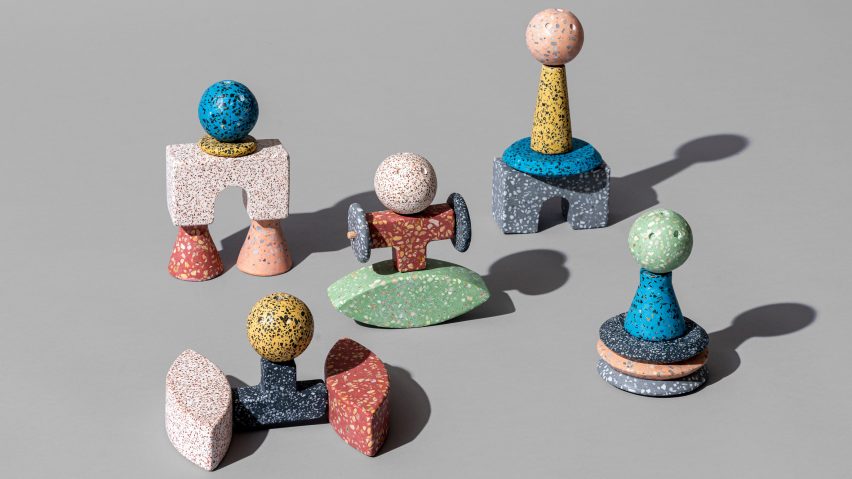Partners at design consultancy Pentagram have created a collection of contemporary tiles and objects for Mallorcan tile brand Huguet, which is on show at London Design Festival and includes glow-in-the-dark tiles.
The project was conceived by designer and former Pentagram partner Astrid Stavro, who helped coordinate the involvement of seven partners from Pentagram's London and New York studios.
The designers were briefed to experiment with materiality and craft, taking advantage of Huguet's capabilities as a manufacturer of artisan tiles, cement and terrazzo.
The seven designers who participated in the project all joined global design consultancy Pentagram as partners in the last seven years.
Their work is predominantly focused on the digital realm, so this project provided an opportunity for a deeper engagement with craftsmanship and local, sustainable materials.
"It was an open brief: there was no limitation or restriction as long as Huguet was capable of manufacturing and developing each concept," explained Stavro, who initiated the project three years ago before leaving Pentagram in 2021 to set up her own studio.
"The underlying concept was to bridge Mediterranean tradition with international contemporary design, blending different cultures and practices with unique points of view," the designer added.
Huguet was established in 1933 and is now run by Biel Huguet, the third generation of his family to oversee the company. Its hand-crafted products are made in small batches and are the result of an approach that combines traditional production methods with contemporary design.
The brand's identity is deeply rooted in Mediterranean culture and takes inspiration from the region's architecture, materials and light.
Pieces are typically developed in collaboration with designers and architects including Herzog & de Meuron, David Chipperfield and Alfredo Häberli.
"This is an extraordinary project for Huguet," said Biel Huguet. "Putting together contemporaneity with tradition, global with local, and international designers with Mediterranean artisans has always been essential for us, and this collaboration is one of the best ways we could have done it."
"We have shared views to blend cultures, to foster diversity and, at the end, to contribute (with a lot of humility), to make a world a little bit richer, a little bit more human, a little bit better, " he added.
The collection includes the Day/Night_Cycle_01 tiles by designer Jody Hudson-Powell, which feature simple surfaces punctuated by a grid of embossed circles.
Flakes of a photoluminescent material incorporated into the cement glow in the dark, adding a surprising element to the design.
"The intention was to create a tile that wasn't inanimate, something which had a consistent form but with materiality that allowed it to change," Hudson-Powell explained.
"The tile bridges the night/day cycle, handing over its role when the shade comes and allowing someone to move through space without the need for electric lighting."
Designer Sascha Lobe's tile design is called Universally Le Corbusier and was inspired by the Swiss architect's study of modules and his use of colour and materials.
The modular system comprises 18 tiles featuring elements that can be combined to form typography or abstract mosaics.
Information designer Giorgia Lupi designed a collection of tiles that represent the 24 Preludes created by Polish composer Frédéric Chopin while living in Mallorca from 1838-39. Each tile features shapes and colours that embody attributes of the compositions, such as the key, tempo and length.
Graphic designer Luke Powell's Streno design is informed by the geological process of stratification. Layers of the normally unseen tile substrate are revealed by grinding away sections of the surfaces.
The swirling layered surfaces contrast with sections of classic white tile that form either a raised or recessed layer. The tiles can be combined in any number of ways to create different patterns.
Stavro herself developed a collection called RE Tiles that focuses on raising awareness of sustainability and climate change. The tiles incorporate recyclable materials endemic to the region, including Posidonia seagrass, which is a vital part of the local ecosystem.
Some designers chose to work in three dimensions, challenging the production skills and capabilities of Huguet's technicians. Sound designer Yuri Suzuki's playful Totem project consists of tactile pieces that can be assembled in different ways to create doll-like figures.
Industrial designer Jon Marshall created a series of three-dimensional planters and garden accessories including rings, cones and discs that can be used to create plant pots, pools, bird baths and seating.
Graphic designer Matt Willey proposed a pair of furniture designs that takes advantage of Huguet's experience working with cast cement. The coffee table features a tray-like top containing 16 handmade Huguet tiles that can be rotated and swapped around to create an ever-changing design.
Willey's writing desk has a wooden base supporting a cement top that folds over to form a shelf and pinboard area. Thirty-nine iron circles incorporated into the tinted cement can be used to attach items with magnets.
The photography is by Andrés Fraga.
The pieces are being exhibited at Cromwell Place as part of Brompton Design District during London Design Festival from 20 to 25 September 2022. See our London Design Festival 2022 guide on Dezeen Events Guide for information about the many other exhibitions, installations and talks taking place throughout the week.

